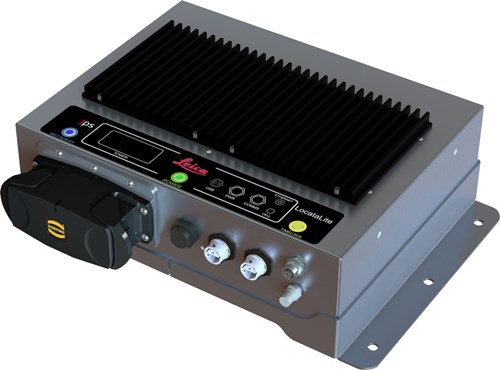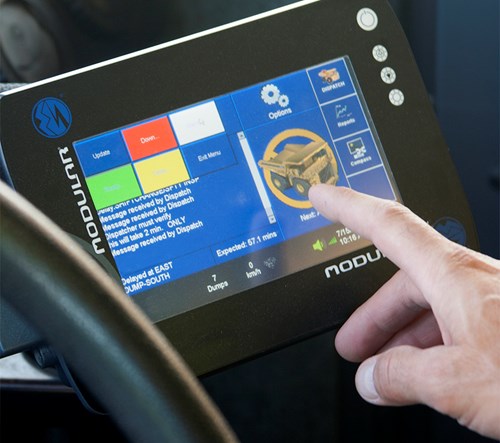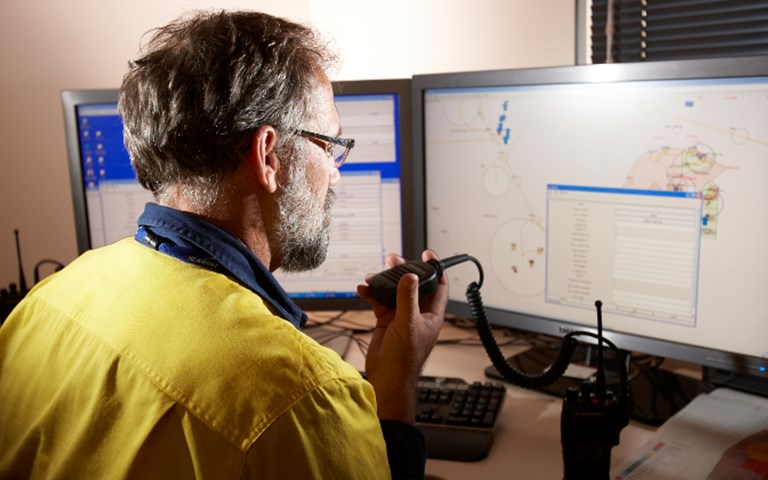A dispatcher monitors a mine’s fleet using Hexagon Mining’s Jmineops. Courtesty of Hexagon Mining
“Massive queuing at the shovels and loaders.” That is how Michael Lewis, vice-president of product innovation at Modular Mining Systems, described the first problem solved by a third-party fleet management system (FMS) in 1979. A modern-day FMS can address vehicle bunching, but these have expanded in scope to solve more than just that problem. Major vendors now deliver products that make real-time, smart decisions for mines, and encompass a much broader range of technologies, analytical tools and ways of accessing data.
The Canadian market for open-pit systems is dominated by Modular Mining’s DISPATCH product, Caterpillar’s MineStar, Wenco’s Wencomine, and Hexagon Mining’s Jigsaw (formerly part of Leica Geosystems). Although three of these systems are owned by equipment manufacturers, they are all compatible with multiple equipment brands and share the same essential features. Relying on now-ubiquitous wireless and radio connectivity at mine sites, the software uses a combination of real-time conditions and the existing mine plan to assign personnel to equipment and to calculate the most cost-efficient routes and schedules for a vehicle fleet. Normally, a dispatcher monitors the system, approves any decisions not carried out automatically, and alters the decision-making algorithms as needed. However, there are small mines that choose a dispatcher-free set-up.
Matthew Desmond, vice-president of global services at Hexagon Mining, sketched out Jigsaw’s capabilities. “It starts with simple things like crew line-up,” he said, “and then efficiently assigning the people to the resource.”
Once machines are operating on site, the system makes decisions based on parameters like traffic on the road, fuel usage and tire temperature. “Whether the tires are getting warmer or cooler will determine which type of route we’ll send the vehicles on,” said Desmond. The type of material being excavated and loaded into the truck is also optimized. Mines that blend together different ore grades can time their excavation so that the blending takes place “live” at the crusher, rather than stockpiling ore first.
At Barrick Gold’s 34-truck Pueblo Viejo mine in the Dominican Republic, a production dispatcher and a maintenance dispatcher cover each shift, overseeing a collection of eight Jigsaw modules that manage drills, shovels, trucks and dozers. Ali Yaguas, FMS coordinator at Pueblo Viejo, noted that Jigsaw’s algorithms calculate routes to minimize the time trucks spend travelling empty by factoring in, among other things, the shovel’s digging rate to set the rhythm for truck loading.
Yaguas has higher ambitions for his FMS: Barrick has embarked on a project to install sensors on vehicles to take advantage of Jigsaw’s condition-monitoring capabilities. Yaguas hopes to eventually gain the capacity to define and recognize specific events. More sensors will, for example, detect if the oil temperature in the loader rises too high, alerting the central FMS that a decision needs to be made about that digging area.

Hexagon Mining’s Jigsaw positioning system (Jps) combines GPS satellites and a ground based network to track vehicles. Courtesy of Hexagon Mining
In that way, Pueblo Viejo is typical. Many mining customers start off with a limited set of capabilities for their FMS, but a growing number of them are experienced technology consumers with high expectations. Major vendors are currently working to meet more comprehensive demands: automated systems with a diversity of technologies, deeper analysis of the data produced and access to that data via the cloud.
Smarter and more integrated
“I think the biggest thing that we’re seeing, within the last five years especially, are trends towards smarter systems with more direct automation,” said David Noble, product manager at Wenco, adding that this leads naturally towards integrating information from other suppliers’ technologies into a client’s FMS.
Wenco’s product uses the Wenco Data Exchange Service – a web service using an application program interface – to hook into other systems. For example, a crusher can have a dispatch-specific programmable logic controller that monitors and reports the crusher’s bin levels or operational status, using the feed from manufacturer-provided sensors. Wenco’s system receives this information in real time and can redirect ore-laden haul trucks as needed.
Mines increasingly look for one-vendor technology suites where they might in the past have pieced together different suppliers’ products. The top four FMS vendors have a number of technologies either included directly in their fleet management product or sold separately, but that are readily integrated with the FMS. Examples include collision avoidance systems and global navigation satellite systems that can track shovel activity very closely, provide important updates on bench progress and help direct the machines.
Data analytics
Some of the integrated systems, especially equipment health monitoring, produce enormous amounts of data. The most frequent questions Wenco gets from prospective customers, according to Noble, are how the reporting works and what kind of access they have to the data. “I think in the end, they know that the data really is one of the most important things a fleet management system provides with its full monitoring of the mission,” he said.
Wenco and parent company Hitachi have been developing more advanced analytics engines to help customers recognize and predict trends. Pueblo Viejo is working on such a project with Hexagon Mining. Meanwhile, Caterpillar joined forces with the data analytics company Uptake in March to develop a predictive diagnostics platform intended to avoid failures. Modular Mining is also working on advanced analytics solutions to automate the analysis of the terabytes of data many of its customers generate each year.
The cloud
All this computing has to take place somewhere, and miners are increasingly interested in minimizing that activity on local servers by trying cloud-based data processing hosted in a central operations centre, on the FMS providers’ servers or via another service provided by the likes of Amazon or Microsoft.
Yaguas said that while Pueblo Viejo’s system is hosted on site, he is very interested in future cloud possibilities. He went on to say he expects that accessing remotely hosted services would cost less than buying and maintaining servers on site. “That’ll be a great opportunity for mining companies during tough economic times,” he commented.
In 2014 Wenco performed a proof-of-concept study with Teck and Hitachi to test the viability of a distributed version of the system using a live mine interface with remote cloud-based database servers. Noble said that to keep up with new trends, Wenco is also rewriting its software to be more web based. “We’re hoping to come out with a [sixth generation] in 2016 that will be all refreshed software,” he said.
Modular Mining will soon roll out a cloud-based solution for its maintenance management offering. “Through its 175-plus OEM interfaces, the system collects telemetry data from all of the different equipment manufacturers’ systems, like an engine monitoring system, drive system or payload, onboard the equipment,” said Lewis. “The data gets transferred into the cloud, where it’s stored and processed. This changes the business model by allowing mines to implement less capital-intensive solutions that are also scalable across corporations. The cloud-based software as a service model helps drive big-data analytics, which is a very exciting area.”
That is not to say the essential scheduling, dispatching and real-time optimization functions of the FMS should always rely on the cloud, cautioned Lewis. “What happens if the Internet goes down for an hour or two at the site?” he asked. “And that still happens. Imagine if you had eight hours a week of downtime for your fleet management product. Not everything is cloud-suitable today.”
Updated software
In addition to developing these big-picture changes, vendors are also making smaller continuous updates. Modular’s updates are often driven by specific customer requests. For example, when a North American customer asked for ways to cut fuel consumption, Modular developed the Idle Monitor module for its DISPATCH system to detect when equipment should be shut off.

Modular Mining’s PTX in-cab mobile platform displays information gathered from its DISPATCH fleet management system. Courtesy of Modular Mining
Desmond said there have been many updates to Jigsaw in 2015 alone. By the end of the year, collision avoidance integration will be released. Another new feature, Jasset, allows the mine to track all mobile and semi-mobile assets, including water pumps and portable toilets, some of which can get misplaced between shift changes. Yet another offering, Jsuper, can now be configured to show the supervisor real-time messages when vehicles exceed speed limits.
Wenco’s onboard haul truck navigation system, PitNav, will soon add peer-to-peer communications to its existing proximity detection offering on heavy machinery and light-duty vehicles so that operators can respond to potential hazards caused by other machines nearby. But with so much activity at a mine site, constant alarms could become annoying or altogether ignored by an operator, so Wenco plans to integrate FMS logic into proximity detection. An alarm will sound, for example, if a light-duty vehicle is following too closely behind a haul truck with a large load that could fall off the back, but there will not be an alarm for expected proximity events such as multiple trucks dumping at the crusher.
Wenco has been redesigning its dashboards and web reports to simplify the interface and support mobile devices, making it accessible to more users. It has also introduced more operator-level customization: a reporting tool that tracks key performance indicators can now display differently on each vehicle to show the operator his or her progress versus targets or fleet averages.
Caterpillar’s MineStar added proximity awareness with its Detect capability set in 2012. Cat’s system filters alarms by machine type and also allows truck drivers to report hazards like rocks in the road. In the last few years, Caterpillar has also created a function to schedule personnel, simplified reporting and improved data analysis in its machine health capability set, and introduced semi-autonomous dozing. Spokesman Mark Sprouls said Caterpillar is working on a platform for portable devices, which would be useful for field supervisors.
User diversity
The most advanced work is taking place in partnership between suppliers and large companies with complex operations. Modular Mining and its parent company, Komatsu, partnered with Rio Tinto in 2011 to run autonomous haulage at Rio Tinto’s Pilbara operations. Cat has autonomous truck fleets at Fortescue Metals Group and BHP Billiton mines in Australia, using the one component of MineStar only available for Cat equipment.
But it is the basic features that consistently attract new users like Copper Mountain in British Columbia, a comparatively small operation that made the leap to an FMS in April 2014. CFO Rod Shier commented, “We initially struggled with the idea of an FMS, but are very glad we moved forward with this type of technology as the benefits are measurable almost immediately.”
CEO Jim O’Rourke, for his part, explained that the dispatcher can now see into places that thinly stretched shift supervisors could not. Before installing the FMS, the mine had unsuccessfully combated a problem with its truck payload measurement, which was reading higher on first loading and then dropping after a few hundred metres as the load began to settle. Modular Mining’s DISPATCH system provides real-time payload information to the dispatcher, who can now quickly catch underloading and ask the operator to add another 10 or so tonnes. Achieving the same productivity gains by adding another truck to its fleet of 21 would have cost about $4 million to buy and $2 million a year to operate.
Desmond said mines with as few as 10 trucks have been looking to FMS in the last few years, often seeking savings in the downturn. “Normally those sites aren’t as driven by technology as the bigger sites that have a hundred or two hundred trucks,” he added. “Technology itself is also evolving, so it’s becoming much more attainable for people now.”






